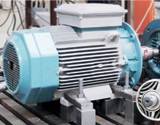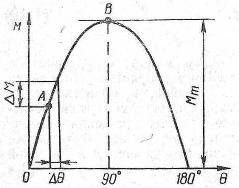Electromechanical properties of synchronous motors
 Synchronous motors in industrial enterprises are used to drive sawmills, compressor and fan units, etc., low-power motors are used in automation systems when a strictly constant speed is required. The mechanical characteristics of the synchronous motor are absolutely rigid.
Synchronous motors in industrial enterprises are used to drive sawmills, compressor and fan units, etc., low-power motors are used in automation systems when a strictly constant speed is required. The mechanical characteristics of the synchronous motor are absolutely rigid.
The torque of a synchronous motor depends on the angle 0 between the axes of the rotor poles and the stator field and is expressed by the formula

where Mm is the maximum torque value.
Dependence M = f (θ) Called the angular characteristic of a synchronous machine (Fig. 1). Engine operation is stable in the initial section of the angular characteristic; usually works at θ no more than 30 — 35 °. As the stability increases, it decreases at the limit point B of the characteristic (θ = 90О) stable operation becomes impossible; the moment corresponding to the limit of stability is called the maximum (overturning) moment.
Rice. 1. Angular characteristic of a synchronous motor
If the synchronous motor is loaded above Mm, then the motor rotor will fall out of synchronism and stop, which is an emergency mode for the machine. The rated torque of the motor is 2-3 times less than the overturning one. Motor torque is proportional to voltage. Synchronous motors are more sensitive to voltage fluctuations than induction motors.
The starting properties of a synchronous motor are characterized not only by the set of starting torque, but also by the magnitude of the input torque Mvx developed by the motor at a slip of 5% from the inclusion of direct current in the excitation winding of the motor. The starting torque multiple is 0.8-1.25, and the input torque is close in magnitude to the starting torque of a synchronous motor.
Relative the complexity of starting synchronous motors and a relatively high price automatic control equipment limit their use in industry.
If the synchronous machine operates at idle speed (angle θ = 0), then the vectors of the network voltage U and the EMF E0 in the armature winding are equal and opposite in phase. By increasing the current in the pole field winding, overexcitation can be created in the machine. In this case, the EMF E0 exceeds the mains voltage U, a current arises in the armature winding

where E is the resulting EMF; xc is the inductive resistance of the armature winding (the active resistance of the winding is usually neglected in a qualitative evaluation of the operating mode of the machine).
Armature current ILegs the resulting EMF E by an angle of 90 °, and with respect to the network voltage vector, it leads 90 ° (the same as when capacitors are connected to the network). Machine works with overexcitation, can be used for reactive power compensation, such a machine is called a synchronous compensator.

